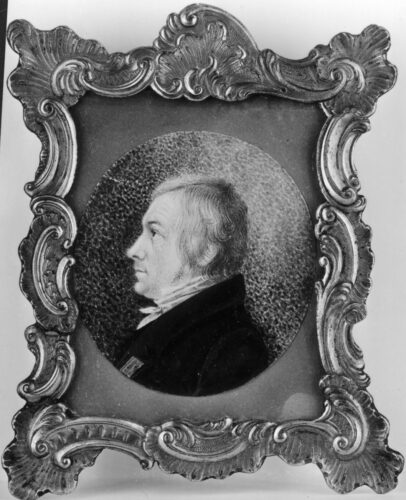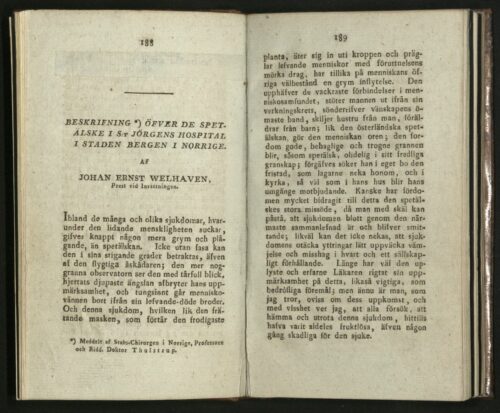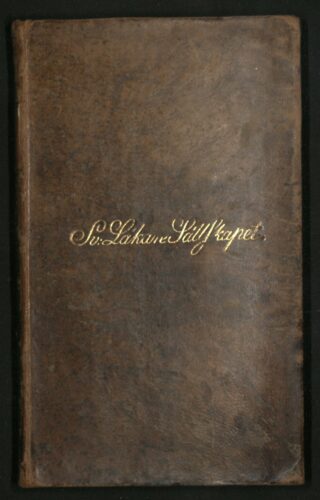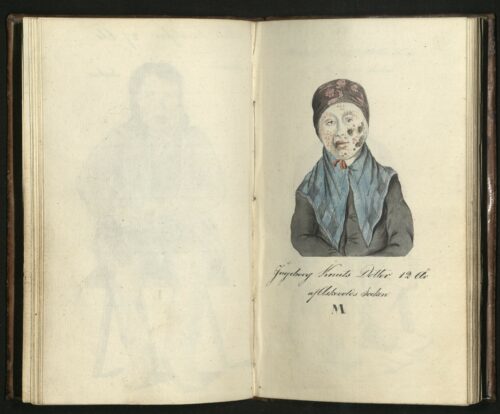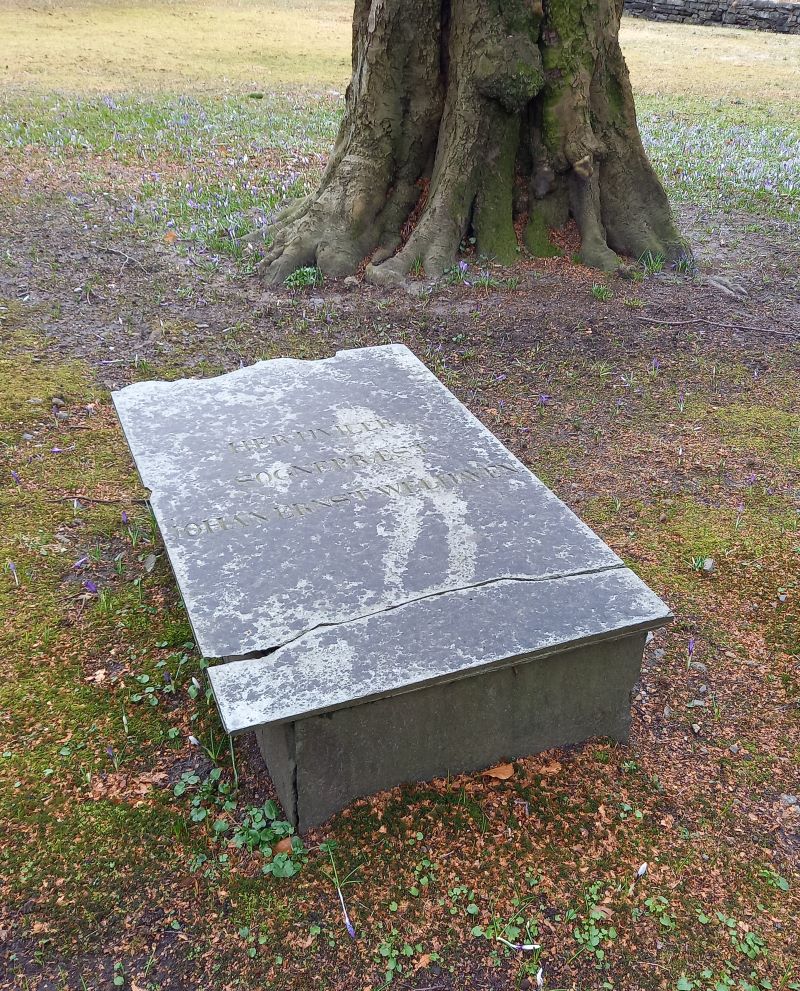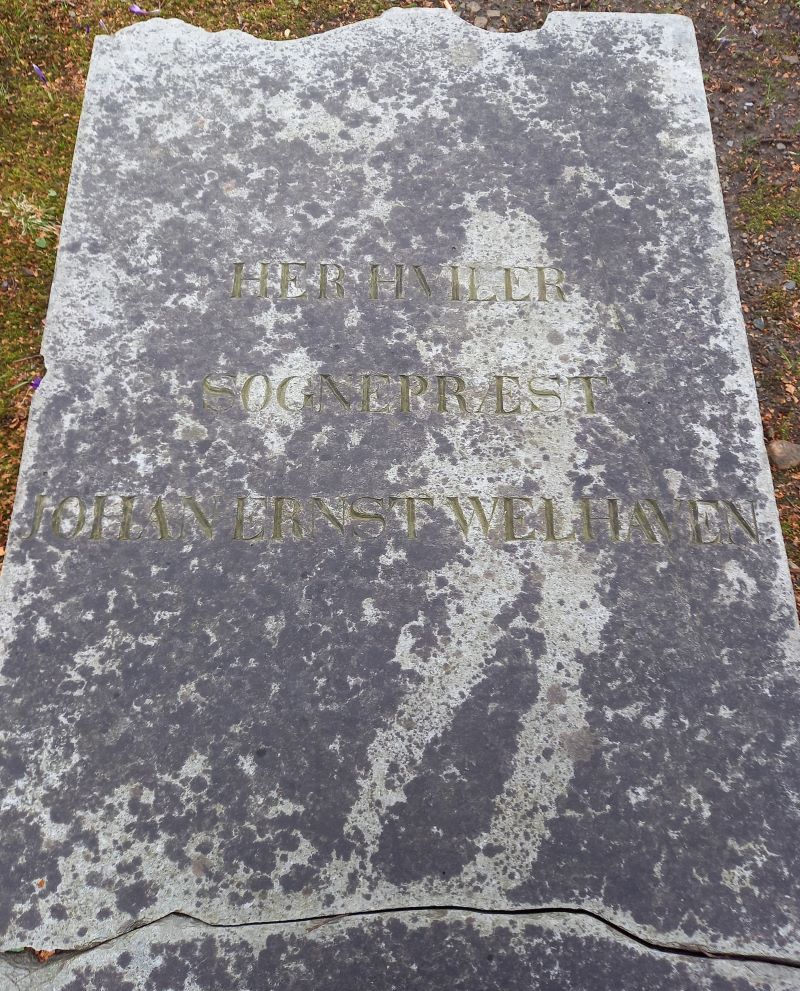Description of the residents at St. Jørgen’s Hospital in the city of Bergen in Norway
by Johan Ernst Welhaven
Chaplain of the hospital.
(…)
For the people suffering from this disease, a facility has been established in Bergen, called St. Jørgen’s Hospital, where, on the approval of the relevant priests and through the diocesan authority, people of both sexes are taken from the city and the countryside, when they, on inspection by the city physician, are found to be afflicted with the disease, without regard to position, age or condition. Nevertheless, it seems to be the case that well-to-do country people in several places are hidden, and are supported and cared for by their relatives at home, however, reportedly, in isolation from the rest of the household. As a chaplain at the hospital for almost 15 years, I have experienced that most of the sick admitted have been of lowly standing, crofters and lodgers, sometimes so impoverished that they did not have a wool blanket with them at the time of admission, and many not even with the most necessary clothes with which to cover themselves.
(…)
Of the various suffering people, there are currently 66 people on the ward of St. Jørgen’s Hospital.
(…)
These unfortunate people’s illness has been considered incurable, which the entire facility with its admissions to the hospital seem to prove since neither doctors nor medication are provided for them.
(…)
Thus, since the use of medicines has hitherto been fruitless for the healing of the sick, appropriate remedies have been sought to alleviate the severe suffering of these people, and clearly ease their burdens. Through the charity of noble people, free medicines are now procured for the members of the hospital, which are purchased at the city’s two apothecaries with the voluntary donations I collect each week. Their soothing agents consist of ointments, oils, mixtures, spices and plasters. Thus, an ointment is prepared by the medical officers, which contains 8 parts thick turpentine, 2 parts pitch plaster, 2 parts calamine, 2 parts linseed oil, which are boiled together and applied to soft pads placed on the wounds. This aforementioned portion is bought almost daily at Svane apothecary, and the sick claim, that without this ointment, which cleanses and softens the wounds, they would not be able to tolerate the pain, were the abrasive wounds to become hard, sharp and tight at the edges, which without this ointment they certainly would. Every four weeks, the hospital distributes camphor spirit with which they are to wash their wounds. Leeches are procured, which are cared for and used by some members of the hospital on the sick, when necessary, and cupping and bloodletting are practised, which the residents much benefit from. Besides the above-mentioned agents, the following medications, dispensed by Løve apothecary, are also used by the sick: camphor oil, juniper oil, St John’s wort oil, turpentine oil, common mother drops, camphor drops, spirit paralyticus, universal balm, basil ointment, white lead ointment, thick turpentine, sulphur powder, burnt alum, liquorice, various mixtures, cough mixtures and spiced teas.
With the help of these remedies, most of the leprosy patients were able to make handicrafts, a job they, in their wretched state, would otherwise have been completely unable to do, as the disease would exhaust their energy and cause them gruesome pain. In relation to their strength, the residents are industrious people; the women spin flax, hemp and wool, sew, knit and weave woollen bands, while the men make boots and shoes for fishermen and farmers, matches, shoe nails, bowls and buckets, as well as agricultural implements and fishing nets.
Their lifestyle is consistent with that to which they have become accustomed at home: fish and bread, porridge and milk are their daily diet, and with that they are quite satisfied, as they get as much as they need. Through the numerous donations, including from farmers, they sometimes get some fresh meat and butter for comfort; but the enjoyment of fresh herring is very harmful to them, and yet it was this, with a few breadcrumbs and at times some old fish, that were the residents’ only means of nutrition and rescue, during the now forgotten days of war and scarcity. I cannot fail to note here the special support I received for this suffering company from compassionate friends, whereby, in particular, in the years 1813 and 1814, they were saved from their impending plight, from hunger itself; for apart from 21 barrels of grain and rye flour and 16 barrels of potatoes, I received in these two years 9,650 riksdaler from seafarers, upstanding citizens and farmers to distribute among the sick, money which was spent partly on medicines and partly on food. Both before and after that time, this charity has strongly benefitted these sick people, and thus I still receive each week significant donations for their upkeep and comfort; through these gifts I have been able to provide them not only with important medication and some food, but also refreshments of tea, sugar, beer and other sour and sweet drinks, yes, at times wine for the comfort of the most sick; likewise, I sometimes receive charpi and linen for their many wounds, of which they also have great need.
As each member of St. Jørgen’s Hospital currently enjoys a subsistence allowance of just 32 Riksbanks-Skilling, they would, without this charitable and important support, come to miss the essentials of life. Without touching upon the hospital’s financial situation, which I do not plan to do, I must note, however, that the aforementioned weekly allowance seems to be completely insufficient for the lepers, and I therefore find these wretches’ daily wish for a larger allowance, very cheap.
Shortcomings that one quickly becomes aware of at this facility are; the nature of the rooms; they are too small and cramped. In a long but narrow building there are 40 chambers, 20 on the upper floor and 20 on the lower floor, each of these chambers has 2 built-in beds, where 2 people sleep; otherwise the room is hardly big enough for 2 people to turn around in at the same time. The stench of the sick makes the air in these cramped rooms highly unhealthy, as I have often experienced to my disgust, when I have been called upon, or when, during my visits to the hospital, I have approached the bedridden residents, especially in the morning hours. This is even the case in the building’s larger rooms or hall, where all the sick gather for their daily work. There, too many gather in one place, so that the air soon becomes contaminated by the many stinking breaths, and the food seems contaminated, as it is in this room that such is consumed, and that, in winter, are put on the stove before the meal.
- They lack a proper doctor and are simply left to themselves, although they do not receive the slightest help towards medication from the hospital; I received no answer to the application I submitted a few years ago; presumably, the institution’s books cannot cover the associated costs.
- They have no proper supervision; for the two nurses, who are to make their beds, and wash their dirty clothes, and also keep the rooms clean, have little time to spare, to change their dressings and care for them in their misery, especially when they are bedridden, and not infrequently there are many such patients.
- The hospital does not provide enough for their subsistence, for if the good people of the city and the countryside, as well as sometimes seafarers, did not make many annual donations, those who cannot work, especially, would die for lack of necessities.
If, therefore, the hospital is not to become hereafter what it so far seems to have been: namely a kind of burial place for the living; then its establishment must be significantly improved. More spacious and airy dwellings must be acquired. Both sexes should live separately from each other, as there could be trouble, which is to be feared, since during the different phases of the disease, there is evidence of an intense sex drive manifesting itself. The same rooms should not be used for both eating and sleeping; just as it would be desirable to have a more orderly system and supervision when the sick make food; they should also not eat what they like, but what under the different stages of the disease would be beneficial to them. And so, as at the hospital, a doctor should be appointed, and from the institution’s funds, necessary medication, as well as linen for their wounds, and a sufficient allowance should be provided.
